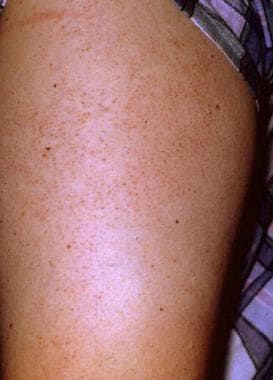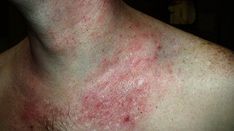History
Patients with keratosis pilaris may report having rough and prickly goose bumps on their skin. They are not painful or significantly pruritic in most patients. About half of all affected patients notice a worsening of symptoms in the winter months. Keratosis pilaris tends to improve over many years.
Physical Examination
Physical examination findings consist of ill-defined groups of small, skin-colored, keratotic, follicular papules, with (keratosis pilaris rubra) or without (keratosis pilaris alba) significant inflammation or perifollicular erythema, as shown below. Keratosis pilaris rubra tends to be more widespread than typical keratosis pilaris. [13]
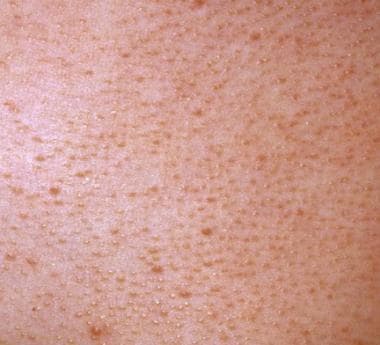 The lesions of keratosis pilaris are evenly spaced, consistent with the follicular origin of this disorder.
The lesions of keratosis pilaris are evenly spaced, consistent with the follicular origin of this disorder.
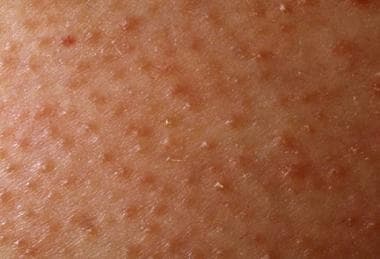 Close examination of keratosis pilaris shows keratotic papules associated with hair follicles. Keratinocytes at the follicular orifice are retained, producing keratin plugs.
Close examination of keratosis pilaris shows keratotic papules associated with hair follicles. Keratinocytes at the follicular orifice are retained, producing keratin plugs.
Occasionally, patients may develop acneiform pustules or cysts, as shown below. A fine hair may pierce the papules, or hair may be found coiled up within the keratin plug. The keratin plug usually cannot be expressed with pressure.
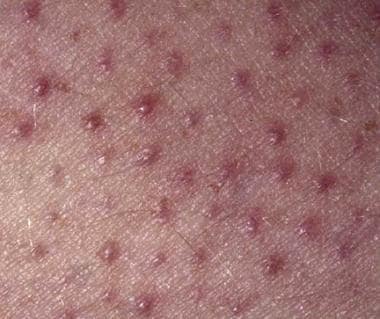 Bacteria associated with the follicular papules of keratosis pilaris may cause some lesions to become erythematous or pustular.
Bacteria associated with the follicular papules of keratosis pilaris may cause some lesions to become erythematous or pustular.
The papules are predominantly located over the posterolateral upper arms and anterior thighs, though they can also involve the face, buttocks, and trunk less commonly. They tend to be monomorphic and evenly spaced.
A pronounced, widespread variant has been described in infants—papular, profuse, and precocious keratosis pilaris. [14]
Complications
Secondary bacterial infections can occur in traumatized lesions in individuals with keratosis pilaris.
-
Keratosis pilaris occurs most commonly on the lateral upper arms and upper thighs.
-
The lesions of keratosis pilaris are evenly spaced, consistent with the follicular origin of this disorder.
-
Close examination of keratosis pilaris shows keratotic papules associated with hair follicles. Keratinocytes at the follicular orifice are retained, producing keratin plugs.
-
Bacteria associated with the follicular papules of keratosis pilaris may cause some lesions to become erythematous or pustular.

